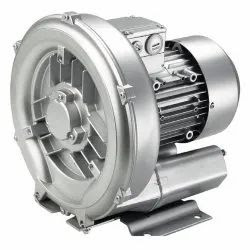Roots® Positive Displacement Blowers
ROOTS® Positive Displacement Blowers are renowned for their efficiency and reliability in various industrial applications. Here’s an overview of these blowers, including their working principle, types, advantages, and applications:
**1. Working Principle
**a. Positive Displacement Mechanism
- Design: Features two or more counter-rotating lobes (roots) inside a casing.
- Function: As the lobes rotate, they trap and compress a fixed volume of air or gas between them and the casing. This trapped air is then pushed through the outlet port.
**b. Airflow and Pressure
- Intake: Air is drawn into the blower as the lobes rotate and create a vacuum.
- Compression: The rotating lobes compress the trapped air as they move towards the discharge port.
- Discharge: The compressed air is expelled through the outlet.
**2. Types of ROOTS® Blowers
**a. Two-Lobe Blowers
- Design: Features two rotors with a simple and robust design.
- Applications: General-purpose industrial use where moderate pressure and flow are required.
**b. Three-Lobe Blowers
- Design: Features three rotors for smoother airflow and reduced pulsation.
- Applications: Suitable for applications requiring high efficiency and reduced noise.
**c. Multi-Lobe Blowers
- Design: Features more than three lobes for specific performance requirements.
- Applications: Used in specialized applications needing customized performance characteristics.
**3. Advantages of ROOTS® Blowers
**a. Consistent Performance
- Benefit: Provides steady and reliable airflow regardless of changes in pressure.
**b. High Efficiency
- Benefit: Delivers high performance with relatively low energy consumption compared to some other types of blowers.
**c. Durability
- Benefit: Designed to withstand harsh conditions and continuous operation, making them suitable for demanding industrial environments.
**d. Low Maintenance
- Benefit: Requires minimal maintenance due to its robust design and fewer moving parts compared to other blower types.
**e. Versatility
- Benefit: Suitable for a wide range of applications, including high-pressure and high-flow requirements.
**4. Applications
**a. Pneumatic Conveying
- Use: Transporting bulk materials like powders, granules, and pellets through pipelines.
**b. Wastewater Treatment
- Use: Aerating wastewater in treatment tanks and providing air for biological processes.
**c. Industrial Ventilation
- Use: Providing airflow for cooling and ventilation in industrial facilities.
**d. Chemical Processing
- Use: Assisting in chemical reactions, blending, and maintaining controlled environments.
**e. Aquaculture
- Use: Aerating fish tanks and ponds to support aquatic life.
**f. Food and Beverage Industry
- Use: Assisting in packaging, cooling, and other processes requiring reliable airflow.
**5. Key Considerations
**a. Capacity and Pressure
- Description: Ensure the blower meets the required flow rate (CFM or m³/h) and pressure (psi or bar) for your specific application.
**b. Material Compatibility
- Description: Select materials that are compatible with the substances being transported or processed to avoid damage and ensure longevity.
**c. Installation
- Description: Proper installation is crucial for optimal performance. Follow manufacturer guidelines for alignment, mounting, and connections.
**d. Maintenance
- Description: Regular maintenance includes checking for wear, lubrication, and cleaning to ensure reliable operation.
**6. Conclusion
ROOTS® Positive Displacement Blowers are essential for various industrial applications due to their reliable performance, efficiency, and durability. Selecting the right type based on your needs and maintaining it properly will ensure optimal performance and longevity. If you have specific questions or need more detailed information, feel free to ask!
